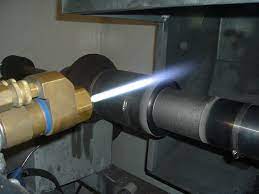

The meaning and characteristics of thermal spraying
Thermal spraying technology refers to a series of processes, in these processes, fine and dispersed metal or non-metallic coating materials, in a melting or semi-melting state, deposited on the surface of the prepared matrix, forming a spray coating layer. Is the use of a certain heat source (such as arc, plasma spraying, etc.) to powder or filament-shaped metal or nonmetallic materials heated to molten or semi-molten state, and then with the help of the flame itself or compressed air at a certain speed to spray to the surface of the pretreated matrix, deposition and formation of a surface coating with various functions of a technology.


The characteristics of thermal spraying :
(1)The substrate is not limited, can be sprayed on a variety of substrates.
(2) Spraying coating materials are very wide, can be used to spray almost all solid engineering materials.
(3) The temperature rise of the substrate material is small in the spraying process, and no stress and deformation are generated.
(4) Flexible and convenient operation process, not limited by the shape of the workpiece, convenient construction.
(5) coating thickness can be from 0.01 to a few millimeters.
(6) coating performance is diverse, can form wear resistance, corrosion resistance, heat insulation, oxidation resistance, insulation, electrical conductivity, radiation and other coating with a variety of special functions.
(7) Strong adaptability and good economic benefits.


Thermal spraying methods include detonation spraying. Wire arc spraying. Flame spraying. High velocity oxy-fuel coating spraying (HVOF).
Due to the advantages of convenient operation, strong adaptability and good economic effect, thermal spraying is widely used in chemical industry (all kinds of containers, reactors, pipelines, pumps, valves and sealing parts), transportation (such as gear shaft, mud pump water seal neck, mud door, mud impeller, sand scraper, etc.). Electric power industry (ball mill, turbine rotor journal and generator rotor journal, cylinder joint surface), metallurgy (blast furnace tuyere, guide roller and delivery roller), etc.
Thermal spraying process:
Thermal spraying workpiece: workpiece surface pretreatment - workpiece preheating - spraying - coating post treatment
Workpiece surface pretreatment: in order to make the coating and the substrate material is well combined, the substrate surface must be clean and rough, there are many ways to purify and coarsely surface, the selection of methods should be based on the suitable requirements of the coating and the substrate material, shape, thickness, surface original condition and construction conditions and other factors.
The purpose of purification treatment is to remove all the dirt on the surface of the workpiece, such as oxide skin, oil stains, etc. The purpose of coarsening treatment is to increase the contact surface between the coating and the matrix material and increase the mechanical biting force between the coating and the matrix material. For some coating materials which are not well bonded with the substrate, a transition layer of coating materials which are bonded with the substrate material should be sprayed, called the bottom layer of the bond, and the thickness is generally 0.8-0.18μm.
Preheating: The purpose is to eliminate moisture and moisture on the surface of the workpiece, improve the interface temperature when spraying particles contact with the workpiece, and improve the binding strength of the coating and the collective.
Spraying
Which spraying method is used for spraying mainly depends on the selected spraying material, the working condition of the workpiece and the requirements for coating quality. The pretreated workpiece should be sprayed in the shortest possible time, and the spraying parameters should be determined according to the coating material, the performance of the spray gun and the specific situation of the workpiece. The optimized spraying conditions can improve the spraying efficiency, and obtain the high-quality coating with high density and high binding strength.
After coating processing: thermal spraying coating sometimes cannot be used directly, mustturningry out a series of post-processing, such as for under impact load or high stress abrasion artifacts, in order to improve the bonding strength of coating, to remelting the coating layer, make the combination of porous and substrate with only mechanical coating into and the density of the metallurgical bonding coating to the substrate.
There are dimensional accuracy requirements, to the coating for mechanical processing. Because the spray coating has different characteristics with the general metal and ceramic materials. The strength of the coating itself is low, can not withstand a large cutting force; In the coating.
Mechanical processing of workpiece after thermal spraying
The above mentioned dimension accuracy requirements of the workpiece, the need for mechanical processing, to ensure the size and accuracy requirements. However, the workpiece hardness after thermal spraying is generally above HRC50, and part of the thermal spraying coating is above HRC65, and there are hard points in the coating, which requires the tool material not only to have high hardness, but also to have good wear resistance and impact resistance.
According to the coating thickness and processing allowance of thermal spraying materials and the substrate material to choose the turning or grinding processing; Due to the low grinding efficiency, the thermal spraying workpiece with small machining allowance and spray thickness is generally selected. On the other hand, when the allowance is large, it is a more economical choice to replace the grinding with turning.
Thermal spraying are widely used in metal surface strengthening, workpiece after thermal spraying, the surface hardness can reach 50 to 55 HRC, general high up to 70 HRC, and most of the coating on the surface of the demand is higher, the surface after spray to cold working, some large machining allowance or restricted to large cylindrical grinding machine equipment, often used in car generation grinding machining method.
1. The type of thermal spraying materials
(1) Types of thermal spraying materials:
Thermal spraying commonly used spraying powder including nickel base, iron base and cobalt base alloy powder, according to different coating hardness, respectively applied to repair and protection of mechanical parts; Spray thickness can be from 0.01 to a few millimeters; The hardness is generally above 50HRC.
General machining allowance and spraying thickness can be used for grinding; On the contrary, instead of grinding car is an economic choice.
2. Cutting tool selection for turning thermal sprayed workpieces
(1) When the hardness of the thermal spray coating is less than HRC45, the carbide tool material can be selected. The commonly used grades are YS30, YG3X, etc., and the line speed can be selected as νc=40 m/min.
(2) When the hardness of the thermal spray coating is greater than HRC45, ceramic or CBN cutters can be used; ceramic cutters and welded composite CBN cutters are often used in finishing due to their poor impact resistance (the cutting depth is preferably within 0.3mm).
(3) When the hardness of the thermal spray coating is greater than HRC55, CBN tools can have better tool life and processing efficiency.
3. Cutting parameters of the tool
(1) When using carbide cutting tools, the cutting depth is usually aO=0.15~0.6mm. The higher the hardness of the surface layer, the smaller the aP should be. aP=0.05~0.1mm during fine turning. The feed rate is generally taken as f=0.1~1mm/r, and f should be smaller during fine turning. The first speed is generally selected according to the hardness of νc=40 m/min; when the hardness of thermal spraying is HRC45-65,choose the carbide tool and the linear speed is better at νc=10 m/min.
(2) When using ceramic cutting tools, the cutting depth is generally controlled within 0.2mm, and the feed rate is about 0.1mm/r; however, the linear speed can be increased to about 3 times that of the original cemented carbide.
--EDITOR:Doris Hu/Anna Wang
---POST: Doris Hu
Semiconductor Industry Solutions
PCD & PCBN Tools Grinding Industry
Diamond Cutting Bruting Polishing
Add: No.171 Zhongyuan Rd, Zhongyuan District, Zhengzhou, 450001, Henan, China
Tel: +86-371-86545906
Phone / Whats App: +86 18339903057
E-mail: [email protected]



